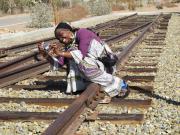Finding Voice
Finding Voice is an innovative literacy and visual arts program in Tucson, Arizona dedicated to helping refugee and immigrant youth in LEARN Center English Language Learner (ELL) classes at Catalina Magnet High School develop their literacy and second language skills by researching, photographing, writing, and speaking out about critical social issues in their lives and communities. Finding Voice educator Julie Kasper (Catalina Magnet High School ELL/English Teacher) and Josh Schachter (Tucson-based photographer and educator) founded the program in spring of 2007 in collaboration with the Tucson chapter of the International Rescue Committee. They worked with 46 students from Afghanistan, Ghana, Honduras, Ivory Coast, Liberia, Mexico, Republic of the Marshall Islands, Sierra Leone, Somalia, and Sudan to help them examine through words and photographs where they came from, where they live now, and to then find their voice in expressing their lived experience. The power and synergy of writing and photography were critical to the success of this project. For many students, taking photographs helped them to determine what matters most to them and provided the motivation to revise and develop their writing. Through this experience, the students developed a better understanding of their Tucson neighborhood and U.S. culture, while keeping a strong connection to their culture and family. They improved their literacy skills, critical thinking and self-confidence. Students who began the project speaking little or no English with strangers finished the year with poise, confidence, and a desire to speak with others about their lives. The students’ work resulted in an exhibit entitled “Home? Teen Refugees & Immigrants Explore Their Tucson,” which was featured in the office gallery of Tucson’s City Councilmember Nina Trasoff. Due to the overwhelmingly positive response to the exhibit by the Tucson community and media, Kasper and Schachter worked with the offices of Senator John McCain, Congressman Raul Grijalva, and Nina Trasoff to expand the impact of the work by displaying it in Washington, DC. The exhibit was shown in June 2008 in the U.S. Senate and six students presented their work and policy recommendations at a Congressional briefing. While working to bring the exhibit to Washington, DC, the Finding Voice program grew and developed in new directions. Kasper and Schachter helped students research, write and photograph their personal experiences with health, war, and immigration. The students hosted three interactive community forums during the school year about these three topics. At the forums, students engaged in dialogue with the community about their lives and together identified actions to address shared issues and concerns. Beyond the forums, the students decided they wanted to reach a more public audience and had their photographs and writings about war and immigration installed for one year in 22 bus stops throughout Tucson. In 2008, the Finding Voice program was one of three arts programs nationwide selected by Animating Democracy, a program of Americans for the Arts, to learn how better to measure the social impact of the program, resulting in a case study by Maribel Alvarez, the evaluation professional who worked with program leaders. During the 2008-2009 school year, the Finding Voice students examined the themes of the “American Dream” and “Change” through research, writing and photography, and shared their work through digital stories, theater, letters to politicians, posters, and community forums. The students also have published their photographs and writing in a book available at www.blurb.com titled “Home? Teen Refugees & Immigrants Explore Their Tucson” and in their annual literary magazine Finding My Voice. Students continue to work through the creative process of brainstorming, researching, drafting, revising, and finally publishing thought-provoking pieces, which they share with the community through exhibitions, community forums, publications, public installation, and the Internet. Organizations and artists associated with this project include: Josh Schachter; Julie Kasper; the Tucson Pima Arts Council; and the International Rescue Committee.
